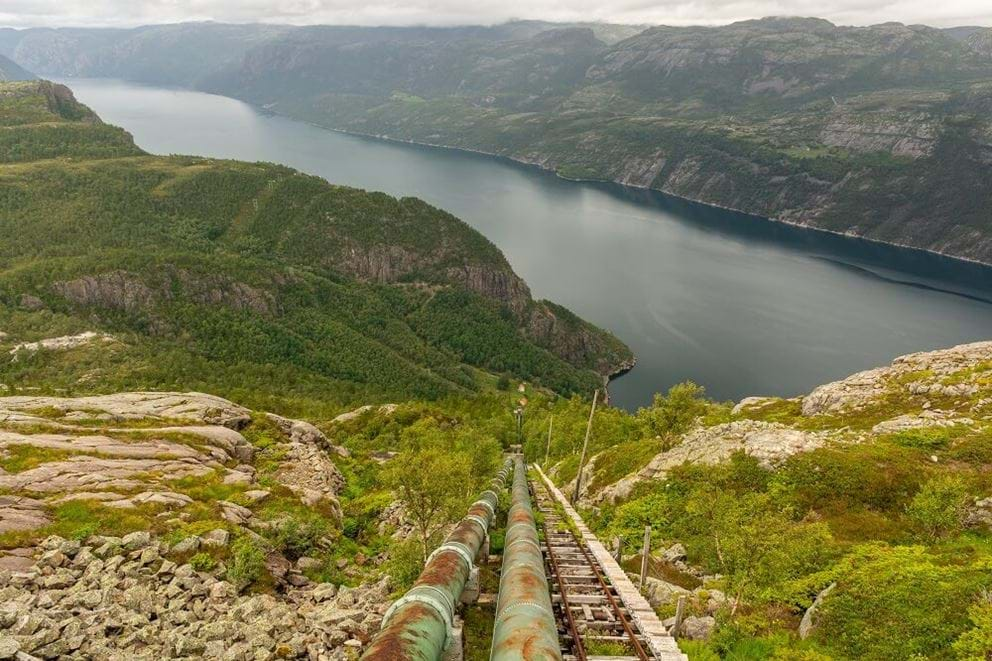The World’s Most Physically Demanding Landmarks

Travel is a passion for many people - nothing quite lives up to the excitement of exploring a new place and enjoying the tastes, scents and sights that come with it. Whether that’s finding a picturesque beach, getting lost in narrow alleyways away from the hubbub of other tourists, or taking in your surroundings from above via a viewing platform.
Every destination has a list of top attractions and things to do, many of which will end up on our must-see lists when we arrive at our location of choice. While many tourist attractions are now accessible via lifts, trains and cable cars, there are some that still require a level of physical exertion to be experienced to their fullest.
Many people will know the feeling of climbing hundreds of stairs and reaching the top of a viewpoint feeling like you’ve just completed a gym class, so we wanted to take a closer look and find out which landmarks are the most physically demanding overall.
The Top 25 Most Physically Demanding Landmarks
To reveal the world’s most physically demanding landmarks, we looked at several factors including the number of steps required to experience the landmark to its fullest, the elevation change during the ascent of the landmark, and the average temperature of the location. These three factors were then used to create a final index score out of 100, to reveal once and for all which landmarks make us work the hardest for an unforgettable cultural experience. The higher the score, the more physical exertion required.
The Flørli Stairs in Norway ranks in first position, followed by the Manitou Incline in the United States and Poenari Castle in Romania in third. The rest of the top 50 is made up of a variety of landmarks - though it’s clear that age-old cathedrals and other religious sites that haven’t been updated with lifts are definitely a common theme when it comes to working hard to get a view!
|
Rank |
Attraction |
Country |
# of Steps |
Elevation Change |
Average Temp (C) |
‘Exertion’ Score /100 |
|
1 |
Flørli Stairs |
Norway |
4,444 |
750 |
11.5 |
76 |
|
2 |
Manitou Incline |
United States |
2,768 |
613 |
16.4 |
63 |
|
3 |
Poenari Castle |
Romania |
1,480 |
800 |
13.1 |
58 |
|
4 |
Konpira-san Shrine |
Japan |
1,368 |
538 |
16.4 |
50 |
|
5 |
Arthur's Seat |
Scotland |
3,200 |
279 |
12.2 |
48 |
|
6 |
Sigiriya |
Sri Lanka |
1,200 |
200 |
27.6 |
46 |
|
7 |
Park Guell |
Spain |
1,984 |
137 |
21.4 |
43 |
|
8 |
Petra Monastery |
Jordan |
800 |
200 |
26.3 |
41 |
|
9 |
Castle of the Moors |
Portugal |
500 |
412 |
19.3 |
41 |
|
10 |
Batu Caves |
Malaysia |
272 |
100 |
32.4 |
40 |
|
11 |
Vindhyagiri Steps |
India |
660 |
143.3 |
27.8 |
39 |
|
12 |
Sydney Harbour Bridge |
Australia |
1332 |
134 |
22.8 |
39 |
|
13 |
Guatapé Rock |
Colombia |
740 |
198.1 |
23.9 |
38 |
|
14 |
Seville Cathedral |
Spain |
700 |
97 |
25.1 |
35 |
|
15 |
Heaven’s Gate |
China |
999 |
120 |
20.9 |
34 |
|
16 |
Monolithos Castle |
Greece |
120 |
236 |
22.3 |
34 |
|
17 |
Christ the Redeemer |
Brazil |
220 |
44 |
27 |
31 |
|
18 |
St. Augustine Lighthouse |
United States |
219 |
42.3 |
26.3 |
30 |
|
19 |
Dubrovnik City Walls |
Croatia |
1080 |
25 |
20.6 |
30 |
|
20 |
Florence Cathedral (Duomo) |
Italy |
414 |
85 |
20.8 |
28 |
|
21 |
Sagrada Familia |
Spain |
504 |
60 |
20.5 |
27 |
|
22 |
Cape Hatteras Lighthouse |
United States |
257 |
60.4 |
22 |
27 |
|
23 |
Palazzo Vecchio |
Italy |
223 |
94 |
20.8 |
27 |
|
24 |
Tokyo Tower |
Japan |
600 |
150 |
15.4 |
27 |
|
25 |
Skellig Michael |
Ireland |
618 |
180 |
13.3 |
26 |
-
Flørli Stairs, Norway
Flørli in Norway is home to a hydroelectric power station, as well as the world’s longest wooden staircase, coming in at 4,444 steps. The staircase follows a pipeline that was used for the old Flørli Power Station, but as this has since been replaced by the new power plant, the staircase and pipeline have been left as a popular activity for tourists visiting the area. Though it has a total ascent of 750m, the climb is said to be child-friendly, thanks to the rails and cables on offer to help support hikers during their climb. However, it may not be best for those with vertigo or a fear of heights, as it is very steep in sections - though the work you put in here is rewarded with some spectacular views. There are several viewpoints and picnic tables along the ascent, so you can take a breather and stop for some lunch if needed, as it’s estimated to take between 3-4 hours to complete the full ascent. A score of 76 out of 100 puts the Flørli Stairs at the top of our rankings and is a physical challenge that should definitely be on your list if you find yourself in Norway!
-
Manitou Incline, United States
The Manitou Incline in Manitou Springs, Colorado is one of the most popular hiking trails in the state - but also one of the most challenging. The Incline ascends on the east slope of Rocky Mountain and follows the remains of a former funicular railway. With sweeping views and an average grade of 45%, and 68% in places, it’s not for the faint hearted. Over the 1.42km distance, hikers gain 613m in elevation, so your legs will definitely get a good workout from this one! Anyone looking to take on the Incline for themselves needs to make a reservation via the City of Colorado Springs website, due to overcrowding of the attraction. With a score of 63 out of 100, the Incline finds itself in second place in our rankings.
-
Poenari Castle, Romania
Also known as Poenari Citadel, the Poenari Castle is the site of a once impenetrable fortress that was a home of Vlad the Impaler. Situated on the top of a mountain and accessed by climbing 1,480 concrete steps, the castle is often called the ‘real Dracula’s castle’ thanks to its connection to the historical figure that inspired the fictional Count Dracula. The position of the castle provides an amazing vantage point over the Arges River Valley and the Vidraru Dam, which will give a great distraction to the muscle aches that are sure to await anyone who tackles the climb. The 800m elevation change, which is the greatest of any of the landmarks analysed, puts the Castle in third place with a score of 58 out of a possible 100.
-
Konpira-san Shrine, Japan
Found on the slopes of Mount Zozu in Kotohira, the climb to Konpira-san, also known as Kotohira-gu, is made up of an arduous 1,368 stone steps. Though it’s one of the trickier shrines to reach in Japan, it is a highly popular site and is visited by pilgrims from across the country. The majority of those who visit only make it to the main hall of the shrine, with the additional 583 steps to the inner shrine, which follows a forested path for a further 45 minutes, reserved for only the most adventurous.
-
Arthur's Seat, Scotland
Arthur’s Seat in Holyrood Park, Edinburgh, is a must-do activity for those visiting the Scottish capital. Though the 279m climb is a continuous one, it’s very popular among even the most inexperienced hiker. The proximity of Holyrood Park to the city makes it easy to reach the site, and also results in panoramic views of the city and beyond throughout the climb. Though it’s not the most technically difficult climb, anyone tackling it is advised to wear boots or good trainers, as it can be slippery in parts. Scoring 48 out of 100, Arthur’s Seat follows closely behind the Konpira-san Shine, with just two points separating the sites.
How can I prepare for visiting a more physically demanding landmark?
Many people may know well ahead of time that there’s going to be some level of physical activity involved in their trip, even if it’s as simple as walking around a city and climbing up to a viewpoint. As a result, this allows some time for light preparation, so you feel physically fit enough to explore the destination to its fullest.
According to Shiv O’Connor, PureGym Leeds based Personal Trainer, the easiest way to prepare for an active holiday is to increase your daily movement in the weeks and months leading up to your trip. You can also add some exercises to build stability, strength, and endurance, particularly in the ankles and knees which can be most affected when walking or climbing a lot.
Squats, calf raises, leg extensions, and hamstring curls will help to strengthen the muscles supporting the knees and ankles, while cardio exercises like incline walking and the StairMaster will help to build cardio endurance while conditioning the body for uphill walking and lots of steps.
How to recover after a day of exploring
Anyone that likes to explore on holiday will know only too well that it is possible for there to be ‘too much of a good thing’. In many cases, our step counts and physical activity levels can be much higher when on holiday than at home, as we try to experience everything our destination has on offer. It’s common for people to leave feeling exhausted and in need of another holiday to try and recover!
Any hikes or climbs up to viewpoints or around landmarks may also leave you feeling a bit sore (particularly if you haven’t worn the right footwear), making it even more important to recover well to avoid feeling out of sorts for the rest of your trip.
We asked Shiv to share her top tips to help you recover after a busy day of exploring, so you can be ready and raring to go again the next day:
-
Keep hydrated
When you’re out and about exploring, it can be easy to lose track of how much water you’re drinking, but staying hydrated will help with recovery. Often our holidays take us to slightly warmer climes than the UK, so this makes it even more essential to drink enough water. Try to carry a big bottle of water around with you, and keep it topped up throughout the day - lots of cities have free drinking water points where you can fill up. If you’re somewhere where it’s recommended to only drink bottled water, plan ahead by carrying a bigger bottle than normal, or buying a top up ahead of any big climbs. The good news is, a beer or two is actually shown to be good for rehydration, as they contain electrolytes, sugar and salt, so you can still enjoy an alcoholic beverage as a reward for your hard work!
-
Have a nutritious meal
It can be easy to forget about nutrition while on holiday and go for just the tastiest foods, but if you’ve had a busy day of exploring, it’s good practice to eat some of each food group to allow your body to recover. Having some protein on your plate will help your muscles to recover, while a big portion of carbohydrates will help you to refuel. It’s likely that you’ll be using more energy than normal, so an extra snack or two throughout the day (gelato, anyone?) will help to keep your energy levels up as well.
-
Add in some stretches
If you’ve been walking around more than normal and have climbed up a tower or two for a good view, your legs may well feel a bit more achey than after an average day. It can be good to do some stretches before getting into bed in the evening, to help loosen up the muscles and relieve any tension. Doing at least two stretches for each of the main muscles in the legs (hamstrings, quads, glutes and calves) should be plenty to ease them off. Check out 10 beginner friendly stretches here.
-
Get a good night’s sleep
Sleep is essential for recovery, and where better to get a good night’s sleep than in a lovely hotel bed?! Many of us enjoy a lie in when on holiday, while others prefer to be up at the crack of dawn to explore - there’s a balance to be found here, so perhaps build in a more relaxed day where you can sleep in a little longer following a big day of exploring.
Looking for a workout class that will help provide the endurance you need for your summer of exploring? Find your nearest PureGym here.
Methodology
A long list of popular landmarks with varying climbs was created using a variety of online sources including blog posts and recommendations from travel sites. Each landmark was evaluated on the number of steps required to climb it to the top/to the highest viewpoint (collated via manual research), total elevation change during the ascent (sourced via manual research, or calculated based on the number of steps) and average temperature (via Met Office or similar). The total elevation/number of steps is what is required to experience it to the fullest - for example, reach the very top of the monument rather than stop at a lower viewing platform.
The three factors were then assigned scores using a weighted scoring system - this method calculates a score for each value based on its relative value compared to the maximum value within the range of all results for the given factor. In this case, each value was multiplied by 33.3 after being divided by the maximum value for that factor. This was repeated across all three factors to provide scores out of 33 for each, with these then combined to give the total ‘exertion’ score out of 100. The landmarks were then ranked from highest to lowest using this final score to provide the rankings.
All data correct as of June 2024.


